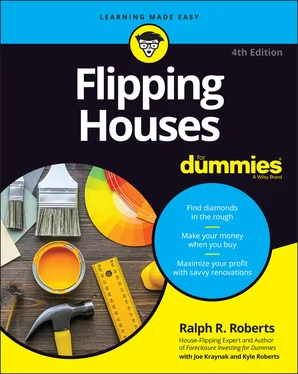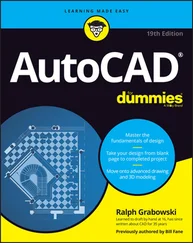Ralph R. Roberts - Flipping Houses For Dummies
Здесь есть возможность читать онлайн «Ralph R. Roberts - Flipping Houses For Dummies» — ознакомительный отрывок электронной книги совершенно бесплатно, а после прочтения отрывка купить полную версию. В некоторых случаях можно слушать аудио, скачать через торрент в формате fb2 и присутствует краткое содержание. Жанр: unrecognised, на английском языке. Описание произведения, (предисловие) а так же отзывы посетителей доступны на портале библиотеки ЛибКат.
- Название:Flipping Houses For Dummies
- Автор:
- Жанр:
- Год:неизвестен
- ISBN:нет данных
- Рейтинг книги:3 / 5. Голосов: 1
-
Избранное:Добавить в избранное
- Отзывы:
-
Ваша оценка:
- 60
- 1
- 2
- 3
- 4
- 5
Flipping Houses For Dummies: краткое содержание, описание и аннотация
Предлагаем к чтению аннотацию, описание, краткое содержание или предисловие (зависит от того, что написал сам автор книги «Flipping Houses For Dummies»). Если вы не нашли необходимую информацию о книге — напишите в комментариях, мы постараемся отыскать её.
Flipping Houses For Dummies
Flipping Houses For Dummies
Flipping Houses For Dummies
Flipping Houses For Dummies — читать онлайн ознакомительный отрывок
Ниже представлен текст книги, разбитый по страницам. Система сохранения места последней прочитанной страницы, позволяет с удобством читать онлайн бесплатно книгу «Flipping Houses For Dummies», без необходимости каждый раз заново искать на чём Вы остановились. Поставьте закладку, и сможете в любой момент перейти на страницу, на которой закончили чтение.
Интервал:
Закладка:
 Home equity loans and lines of credit often come with adjustable interest rates, which carry additional risks. If the rate jumps significantly, it can make the monthly payments unaffordable and place your home at risk of foreclosure. Consider the worst-case scenario. What’s the highest the rate can go, and how much would the monthly payment be at that rate? If there’s any chance you won’t be able to afford the monthly payments, don’t do the loan.
Home equity loans and lines of credit often come with adjustable interest rates, which carry additional risks. If the rate jumps significantly, it can make the monthly payments unaffordable and place your home at risk of foreclosure. Consider the worst-case scenario. What’s the highest the rate can go, and how much would the monthly payment be at that rate? If there’s any chance you won’t be able to afford the monthly payments, don’t do the loan.
Taking out a home equity loan or line of credit may be a better financial choice than refinancing your current mortgage in the following situations:
The interest rate on your first mortgage is low compared to current interest rates. If your current mortgage interest rate is 4.5 percent, refinancing to a mortgage at 8 percent is probably a poor choice. Keeping that mortgage in place and taking out a separate home equity or line of credit loan may be a better choice.
You’ve been paying on your first mortgage for several years. With every payment you make, you pay more on principal and less on interest, so if you’ve been paying 15 years on a 30-year mortgage, refinancing now may cost you in the long run. Again, a home equity loan or line of credit may be the better option.
You can quickly flip the property you’re investing in and pay off the home equity loan or line of credit. Assuming that the loan has no prepayment penalty, if you can unlock the equity in your home and then quickly pay back the money, you retain your home’s equity.
 Home equity loans and lines of credit are almost always preferable to refinancing an existing mortgage, assuming that you can secure a low-cost, low-interest, fixed-rate loan or line of credit, because they’re reusable. That is, you can pay down the amount you owe on a home equity loan or line of credit and then have it to reuse for another project. When you refinance a mortgage, you replace it with a new mortgage that’s not reusable; after you pay it off, that credit is no longer available.
Home equity loans and lines of credit are almost always preferable to refinancing an existing mortgage, assuming that you can secure a low-cost, low-interest, fixed-rate loan or line of credit, because they’re reusable. That is, you can pay down the amount you owe on a home equity loan or line of credit and then have it to reuse for another project. When you refinance a mortgage, you replace it with a new mortgage that’s not reusable; after you pay it off, that credit is no longer available.
Cracking open your retirement nest egg
Newcomers are often attracted to real estate investments because they may result in a higher percentage return than stocks or bonds. In addition, real estate gives you more control over the performance of your investment. In the case of flipping houses, if you do it right and don’t fall victim to a burst housing bubble, you stand to earn 20 percent or more on each house you flip. You’re not likely to see that sort of return on stocks and bonds!
Because real estate is an investment opportunity that’s as legitimate as stocks and bonds, some real estate investors are choosing to structure their IRAs (or at least a portion of them) around real estate investments. In other words, you can convert your IRA into a self-directed IRA and use the money in your retirement account to fuel your flips. Consult your accountant and your personal finance specialist to determine whether this option is one you want to explore and to work out all the details if you choose to go this route. It’s risky, but so is the stock market.
 I use a company called Equity Trust (
I use a company called Equity Trust ( www.trustetc.com ). The people there are helpful, offer webinars, and try to educate you on how to use a self-directed IRA as a tool to buy and flip real estate.
 Another way to use your retirement income to help fuel a flip is to borrow from it to obtain enough cash to make a down payment on a loan to fund the purchase and repairs. For example, if you are applying for a $100,000 loan to flip a house and are required to put 10 percent down, you can borrow $10,000 from your retirement account to use for the down payment. You need to make monthly payments on that $10,000 as you would for any loan, but then you could pay off the loan (reimburse your account) after you sell the property. The interest is paid to your retirement account, and you’re not required to pay taxes or early withdrawal penalties on that $10,000, so you’re really not losing anything as long as you pay back the loan in full. Consult your retirement plan manager or financial advisor for details and to explain any possible ramifications of borrowing from your retirement account.
Another way to use your retirement income to help fuel a flip is to borrow from it to obtain enough cash to make a down payment on a loan to fund the purchase and repairs. For example, if you are applying for a $100,000 loan to flip a house and are required to put 10 percent down, you can borrow $10,000 from your retirement account to use for the down payment. You need to make monthly payments on that $10,000 as you would for any loan, but then you could pay off the loan (reimburse your account) after you sell the property. The interest is paid to your retirement account, and you’re not required to pay taxes or early withdrawal penalties on that $10,000, so you’re really not losing anything as long as you pay back the loan in full. Consult your retirement plan manager or financial advisor for details and to explain any possible ramifications of borrowing from your retirement account.
Leveraging the Power of Other People’s Money
Many people have an aversion to borrowing money, and for good reason — it costs money to spend money you don’t have, and when you spend money you don’t have, you don’t have money to pay back the money you borrowed. It certainly does cause a lot of problems for some people.
However, very lucrative businesses and individuals have made their fortunes on borrowed money. The not-so-secret secret is to use that borrowed money to earn far more money than you’re paying to borrow that money. That’s called leverage. You use a little of the money you have and a lot of other people’s money (OPM) to make a much bigger investment than you could otherwise afford on your own. Do it right, and you can pay off the loan and pocket a handsome profit.
With house flipping, your goal is to move as much house as you can with as little of your own money as possible. If you invest $100,000 of your own money in a property, for example, and you flip it for a profit of $20,000, you make a 20 percent profit on your $100,000 investment. On the other hand, if you invest $20,000 of your own money, borrow $80,000, and sell the property for $120,000, you earn closer to a 100 percent profit, because you’re seeing a $20,000 profit on $20,000 of your money. (I say closer to 100 percent, because these numbers don’t account for interest on the $80,000 borrowed, holding costs, and other factors.)
To look at it another way, suppose you have $100,000 to invest. Many people assume that using that $100,000 to finance a single flip is the smart thing to do, because you avoid paying interest on borrowed money. However, by leveraging that $100,000 with borrowed money, you stand to earn a bigger profit. For example, you can combine that $100,000 with borrowed money to flip a higher-priced property — perhaps a $500,000 house that you know you can sell in the $575,000 to $600,000 range.
 Borrowing money is always risky, but you need to take some risk to earn the big bucks. Throughout this book, I show you ways to reduce risk, but unforeseen events can undermine the best-laid plans. As a flipper, you need to decide for yourself whether the potential benefits outweigh the risks.
Borrowing money is always risky, but you need to take some risk to earn the big bucks. Throughout this book, I show you ways to reduce risk, but unforeseen events can undermine the best-laid plans. As a flipper, you need to decide for yourself whether the potential benefits outweigh the risks.
The following sections show you how to gain leverage by using other people’s money to finance your flips. And if you don’t have money, I show you how to persuade private lenders to put up some initial investment capital to get you started.
Persuading a bank to finance your flips
Since the mortgage meltdown of 2008, banks have tightened their criteria for approving loans. However, they’re still eager to loan money. After all, that’s how they earn their money. You just need to be able to persuade the decision makers at the bank that you can make the loan payments and pay back the loan on time with interest. The key is to earn their confidence in you.
Читать дальшеИнтервал:
Закладка:
Похожие книги на «Flipping Houses For Dummies»
Представляем Вашему вниманию похожие книги на «Flipping Houses For Dummies» списком для выбора. Мы отобрали схожую по названию и смыслу литературу в надежде предоставить читателям больше вариантов отыскать новые, интересные, ещё непрочитанные произведения.
Обсуждение, отзывы о книге «Flipping Houses For Dummies» и просто собственные мнения читателей. Оставьте ваши комментарии, напишите, что Вы думаете о произведении, его смысле или главных героях. Укажите что конкретно понравилось, а что нет, и почему Вы так считаете.












